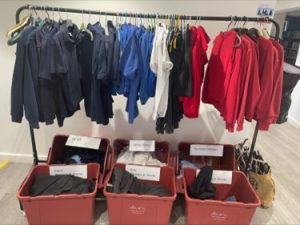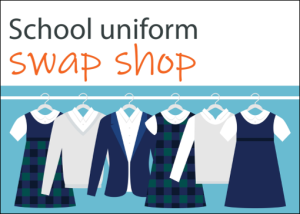Wear, Care and Repair Case study – Award-winning school uniform swap shop
North West Leicestershire – Award-winning school uniform swap shop
North West Leicestershire District Council (NWLDC) set up a school uniform swap shop across the area in 2023. They were aware that families were struggling to manage the expense of school uniforms while juggling household bills, especially during the school holiday period when extra food was required. Their aim was to reduce costs to families and thus see a reduction in the need for food provision across the district. It was also recognised that in the first week of the summer holidays, school uniforms were often thrown away when no longer required.
The initiative encouraged and supported families to donate uniforms that no longer fitted or were no longer needed and in turn, these uniforms were then available for other families to pick up and make use of for free. There was no requirement to donate a uniform in order to take a uniform.
The project was set up to cover the whole district rather than individual schools, which made it particularly efficient. All schools and their respective uniforms were covered – in total three full uniform sets. The project was open to everyone. Anyone could be involved and host a swap shop, including businesses, community groups, supermarkets or local stores and district council teams. The inclusivity of the scheme helped to make it accessible to all.
The swap shops ran for seven weeks during the summer holidays and the venues were selected for having good opening hours. All venues hosting a swap shop were allocated a clothes rail and hangers for displaying the uniforms. They also had a set of boxes or containers clearly labelled for parts of the uniform that weren’t suitable for hanging, such as footwear, ties, PE kits, etc.
A range of posters were designed to help promote the initiative, including one requesting donations, one giving instructions of where to locate the swap shops, and one giving instructions on how to use the swap shops. In total there were 20 different clothes rails displaying uniforms and as many as 2000 different items of clothing on offer.

The project was deemed successful, seeing a definite and steady reduction in food provisions as it continued. At the end of the summer scheme any remaining uniform items were collected and donated to a Nottingham social justice charity, HIMMAH, which helps to tackle food poverty, racism and educational inequalities. In addition to all the uniforms that they’d already rehomed, they donated 90.7kg of remaining school uniform items to the Nottingham charity, helping to divert it from landfill.
In May 2024 NWLDC won the Reuse Initiative of the Year in 2024 Award for Excellence in Recycling and Waste Management. The project was extended into 2024 and is still going strong. After the two years of running, food provisions within the district dropped by half and payments of council tax were also seen to improve.
In the second year the project focused on two full uniform sets, instead of three, with 14 venues hosting the swap shops and 18 rails of clothes. The costs of running the scheme and the man hours required, reduced significantly and at the end of the project they donated 442 kg of remaining school uniform items to local charity, Leicestershire Children’s Holidays, who then set up their own scheme.
In October 2024 the scheme won a second national award, Best Waste Minimisation or Prevention Project at the Local Authority Recycling Advisory Committee (LARAC) Conference Celebration Awards.
Hinckley & Bosworth Borough Council

In 2024, Hinckley & Bosworth BC set up a similar school uniform scheme, delivering the same project model as NWLDC. Their initiative covered over 50 schools in the borough, across nine locations. The school uniform swap shops were hosted across the district in various shops and community venues. The project was promoted through schools, social prescribers and social media. They also achieved a reduction in food bank usage across the borough and found that their social media campaign really helped to boost awareness of the project. Due to the success of the project, they are now looking to introduce a coat exchange during the winter.
Also in Wear, Care and Repair Sub menu











